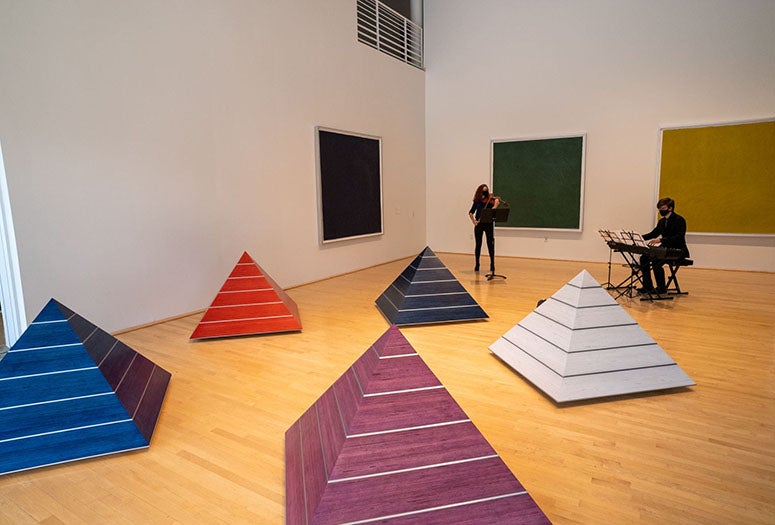The most apparent inspiration for “did old yeller really fight a bear,” a newly composed piece for cello by Nicky Sohn, a graduate student in Rice’s Shepherd School of Music, is in its title.
Sohn saw the 1957 Disney classic “Old Yeller,” set in Texas in the 1860s, for the first time last year while binge-watching old Westerns. She found its positivity charming, despite that infamous ending. But Sohn also took inspiration, she said, from David Novros’ large-scale works on display at the Moody Center for the Arts in its current spring exhibition, “Artists and the Rothko Chapel: 50 Years of Inspiration.”
“When I came to the Moody Center a few weeks ago to check out the exhibition and I entered the room that Novros created I just got a lot of vibrant, energetic feelings that I associated with ‘Old Yeller,’ the movie, so I thought it would be interesting to put those two pieces together and see what comes out,” Sohn said.
Her expressive composition was performed March 27 by fellow Shepherd School student Caio Alvez Diniz inside that same Novros “room” at the Moody. Sohn’s work was one of five featured in this semester’s New Art/New Music program.
With each new show at the Moody, the New Art/New Music collaboration with the Shepherd School invites students to respond to artworks on display with a composition that’s then performed alongside the art — a sort of conversation between artists across space and time.
Just as Novros drew his inspiration in the 1970s from the mid-century work of Mark Rothko and his namesake chapel, the New Art/New Music program encourages undergraduates and grad students to draw on the contemporary art exhibited each semester at the Moody when selecting or composing their contemporary “new music” pieces.
Despite its name, new music has been with us for a while: Prominent contemporary composer Morton Feldman, who was deeply influenced by the same abstract expressionist movement, wrote arguably his best known piece in 1971, the 25-minute “Rothko Chapel” for mixed choir and instruments, performed in the chapel on the Menil Collection campus.
And in keeping with tradition, all of this semester’s New Art/New Music compositions were performed in front of their partner pieces at the Moody.
Since January, Hanszen College senior Lucas Lemonholm has been working as a student docent inside the intimate Moody gallery that’s currently home to a series of Byron Kim works that depict the evening sky in various shades of gray and blue. And since his sophomore year, Lemonholm has also helped coordinate the New Art/New Music program.
Lemonholm was eagerly awaiting the Rothko Chapel-inspired show at the Moody, but was surprised to find just how much he enjoyed Kim’s night-sky pieces, which felt “static” at first but came to life the more Lemonholm spent time with them.
A string quartet of Shepherd School students performed Lemonholm’s new composition “Looking Out” while surrounded by Kim’s paintings, just as Lemonholm himself has spent the semester communing with the pieces.
“A feature that I am drawn to in both Kim’s art and the art in the Rothko Chapel is its unobtrusiveness — that instead of demanding an emotional response, it invites one,” he said.
Duncan College freshman Olivia Bennett was similarly inspired by Kim’s “Urban Night” series, the setting of which evokes sitting in the tranquil environment of the Rothko Chapel.
“It’s very meditative and it’s very calming and it enables you to not only reflect on the art, but on yourself as a human being and understand the reality you’re in at the present moment,” said Bennett, whose “Obsolete” for oboe and harpsichord is similarly reflective.
Wiess College freshman Alex Moreno employed the warm alto voice of the viola and subtle jazz syncopation on the piano to reflect on the work of Sam Gilliam, whose monumental washi paper paintings were similarly influenced by jazz, in a movement from his “Concertino para Viola.”
Gilliam’s five pyramidal sculptures — which sit adjacent to his washi paper paintings in the Moody’s Central Gallery — spoke to graduate student Daniel Zlatkin, and the unmistakable tones and motifs of jazz echo here as well in Zlatkin’s “Austere Etudes,” performed on horn by fellow grad student Lauren Anker.
“Although I originally wrote this piece as a set of miniatures focusing on different aspects of horn technique, I felt a resonance between the music and Sam Gilliam’s ‘Five Pyramids,’” Zlatkin said.
Each movement of “Austere Etudes,” which he describes as “stark and angular,” focuses on a different color — and despite sharing similar forms, none of the movements blend into one another. They draw clear inspiration from each other, but stand on their own; it’s also an apt metaphor for the Rothko Chapel-influenced works on display at the Moody right now.
“There’s no doubt they belong together,” Zlatkin said. “There’s an underlying electricity.”

